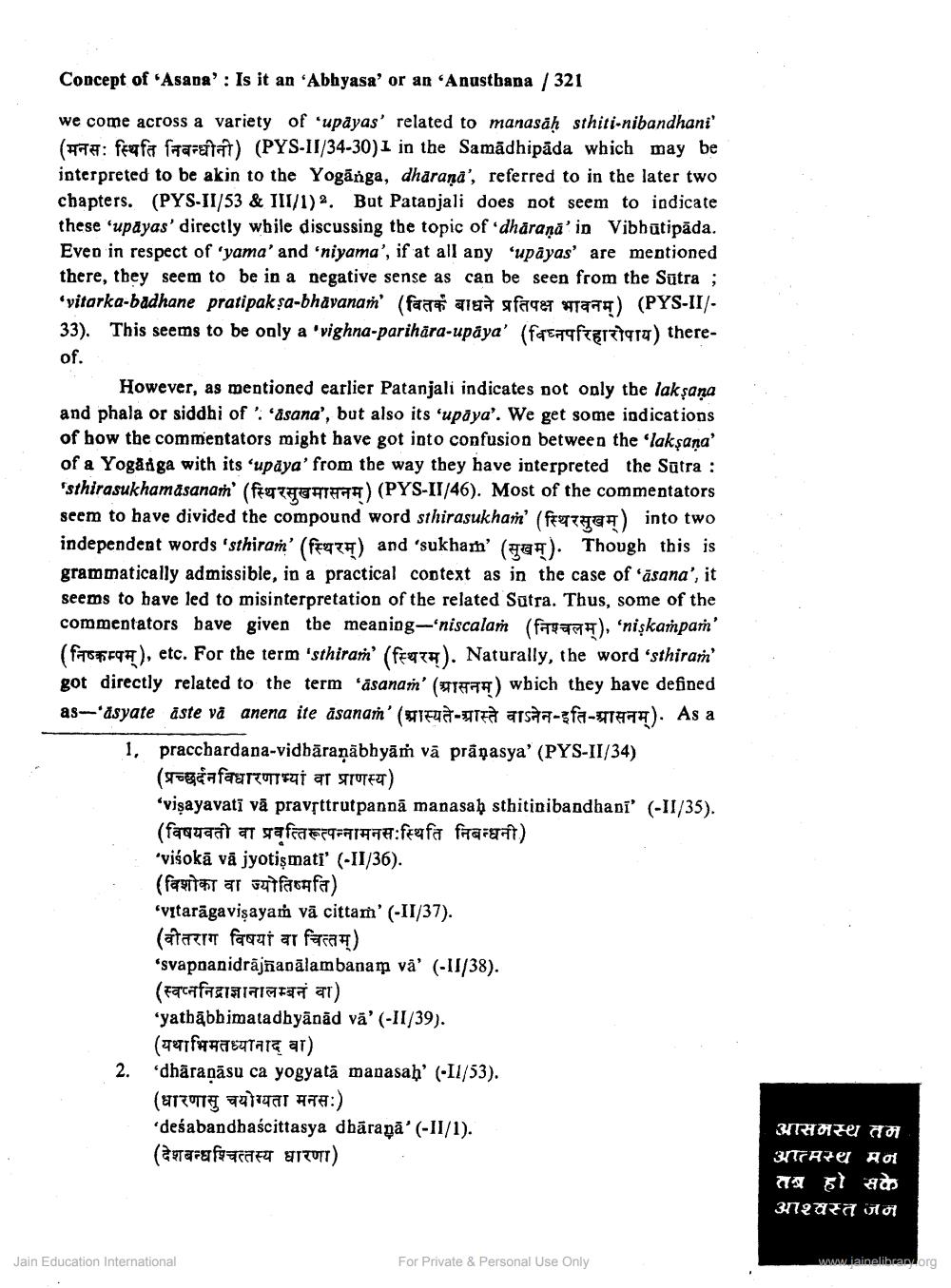Book Title: Concept on Asana Is it Abhbyasa or Anusthana Author(s): B R Sharma, T P Sreekumaran, M V Bhole Publisher: Z_Umravkunvarji_Diksha_Swarna_Jayanti_Smruti_Granth_012035.pdf View full book textPage 4
________________ Concept of Asana': Is it an 'Abhyasa' or an 'Anastbana / 321 we come across a variety of 'upayas' related to manasah sthiti-nibandhani' (HT: fenfa faaruitat) (PYS-11/34-30)1 in the Samadhipada which may be interpreted to be akin to the Yogānga, dharana', referred to in the later two chapters. (PYS-11/53 & 111/1). But Patanjali does not seem to indicate these 'upayas' directly while discussing the topic of dharană' in Vibhutipāda. Even in respect of 'yama' and 'niyama', if at all any ‘upāyas' are mentioned there, they seem to be in a negative sense as can be seen from the Sutra ; 'vitarka-badhane pratipak şa-bhavanam' (faat aina gfaget CTH) (PYS-II/33). This seems to be only a 'vighna-parihara-upaya' (fagfrarstaro) thereof. However, as mentioned earlier Patanjali indicates not only the laksana and phala or siddhi of ': 'asana', but also its 'upāya'. We get some indications of how the commentators might have got into confusion between the 'lakşana' of a Yogårga with its ‘upaya' from the way they have interpreted the Sūtra : sthirasukhamasanam (fyzHEFTET) (PYS-IT/46). Most of the commentators seem to have divided the compound word sthirasukham' ( f a ) into two independent words 'sthiram' (froze) and 'sukham' (a). Though this is grammatically admissible, in a practical context as in the case of 'äsana', it seems to have led to misinterpretation of the related Sutra. Thus, some of the commentators have given the meaning-niscalar (1977), 'niskampam' ( FH), etc. For the term 'sthiran' (feath). Naturally, the word 'sthiram got directly related to the term 'asanan' (197) wbich they have defined as-'asyate aste và anena ite asanam' ( ud-gita arta-fa-919974). As a 1, pracchardana-vidbäraņābhyāṁ vā prāṇasya' (PYS-II/34) (प्रच्छर्दन विधारणाभ्यां वा प्राणस्य) "vişayavatī vā pravsttrutpannā manasaḥ sthitinibandhani' (-II/35). (विषयवती वा प्रवत्तिरूत्पन्नामनस:स्थिति निबन्धनी) 'visokā vā jyotişmati' (-II/36). (fasta ar Jutfarafa) 'vitarāgavişayam vā cittam' (-II/37). (वीतराग विषयां वा चित्तम्) *svapnanidrājñanālambanam vă' (-11/38). (स्वप्ननिद्राज्ञानालम्बनं वा) ‘yathābbimatadhyānād vā' (-II/39). (fastarą ar) dhäranāsu ca yogyatā manasaḥ' (-11/53). (धारणासु चयोग्यता मनसः) deśabandhaścittasya dbāraṇā' (-11/1). (agrarafgaaf grTO) आसमस्थ तम आत्मस्थ मन तब हो सके आश्वस्त जन Jain Education International For Private & Personal Use Only www.iainelibrandorgPage Navigation
1 2 3 4 5 6
